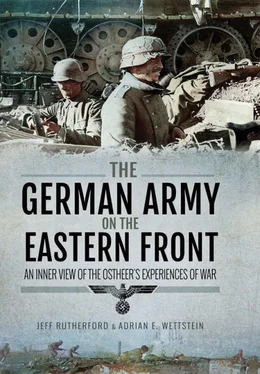In this context, one cannot emphasize enough a good training, with sufficient time, of low-level leaders of all ranks, particularly the lower ones. Special arrangements of training are necessary. With them, the troops stand and fall. [9]
The source also points out again the importance of low-level leadership for the combat power of the troops, but also the need for training of those leaders behind the front line. What would such training look like?
The following order originates from the 58th Infantry Division, whose commander, Generalmajor Friedrich Altrichter, one of Germany’s most prolific writers on military psychology and officer training, gives an idea about leadership training of frontline units. [10]
1) Objective of the leadership training
The training of the officers and NCOs is of decisive importance for the fighting power of the troops. The training of the officers and NCOs has the objective of raising their professional skills, strengthening their authority, providing them with uniform perceptions and convictions.
It is frequently noted that in front of their men, officers and NCOs stand their ground before the enemy, but are not capable of acting as tactical leaders, instructors, and educators of their men. In order to master these tasks, a certain amount of knowledge and insight is necessary, which can only be gained through proper special training.
2) Organization of Leadership Training
Leadership training is divided into:
A) Commander’s Course
B) Training of officers by regimental and battalion commanders
C) Training of NCOs
D) Map exercises
3) Execution of leadership training in detail
To point 2) A Commanders’ Course
Purpose: Instruction on the tasks as battalion commander, to deepen the knowledge of the service, to teach the principles of education and training of officers, uniform approach to the handling and organization of the individual service issues.
Head: Division commander
[…]
Participants: the regimental and battalion commanders as well as their deputies.
On 2) B Training of the officers by regimental and battalion commanders
Purpose: To provide guidance on the attitude and concept of being an officer, to teach about the principles of education and training, to train as a tactical leader of their unit, to guide the handling of routine service in a company (battery).
Head: In the present tactical conditions, the officers’ training rests mainly in the hands of the battalion commanders. It is their most important task during the pause in operations.
[…] Time: In December 2-3 times weekly (main focus of this time to lay the foundation). From January once weekly.
[…] Duration: the whole winter
Participants: all officers, platoon leaders and officer’s candidates of the battalions.
To 2) C Training of NCOs
It is divided into: a) The training of NCOs by the company commanders and b) The regiments’ NCO candidate courses.
To a) NCO training by the company (battery) commanders
Purpose: instruction in the treatment and education of subordinates, direction as an instructor, training as a leader, strengthening of their position as a superior by developing [the necessary] personality and acquiring increased professional knowledge and skills.
[…] Participants: all NCOs and NCO candidates of the companies.
To b) Regimental NCO candidates courses
Purpose: To instruct on NCOs’ duties, to provide the service knowledge, to provide guidance in handling the practical service, to train as a leader of a detachment, to strengthen the military conception and attitude. In the case of NCO candidates, check for suitability to become NCO.
Leader: 1 experienced officer by order of the regiments
Course duration: 14 days
[…] Participants: All NCO candidates as well as young NCOs by order of the regiments
To D) Map exercises
Purpose: Clarification of tactical questions and terms, training in decision-making, exercise in the giving of orders, instruction in the interaction of the different weapons, guidance in the leading of one’s own and the next higher unit.
Head: Regimental commanders
Beginning: January 1942. The number of map exercises is left to the regiments.
Participants: The officers of the regiments according to instructions of the regimental commanders. In infantry map exercises, officers of the artillery, engineers, anti-tank and signal units are to be principally involved as well as infantry and engineer officers in map exercises of the artillery. […]
4) It is envisaged to set up a divisional company leaders’ course. The final decision on this question [will be taken], as soon as it becomes clear whether and which company leader training courses take place in the army or in the Heimat . The divisional company leader course could not be established before February 1942.
Leadership training was understood as a key factor of combat power. The training was carried out level by level. The divisional commander gathered his regimental and battalion commanders in the commander’s course not only to lay the foundation for leadership training, but also to achieve a unified understanding among his officers. The regimental and battalion commanders would then train and educate their officers, the NCOs of their units. To train and mould the younger NCOs and NCO candidates, special courses were carried out in each regiment. The same was intended for new or designated company leaders. While not mentioned here, battalion commanders’ courses were also soon ordered (normally at army or army group level due to the need for an instruction troop of several companies), as were staff officer courses. Finally, to provide advanced tactical training, but also again to unify understanding, the army held map exercises.
Looking at its subject matter, the order included as much on tactical themes as it did on daily services and the issue of leading men. Also important was the education of officer values. This is more clearly indicated in the annex to the order: [11]
I. Guidelines and aspects for carrying out leadership training
1) Basic principles
The training of the leaders and NCOs is divided into the following areas:
a) Instruction as an educator, b) Instruction as an trainer, c) Training as a leader
A major error, which is to be found again and again, consists in too much one-sidedness in leadership training. It is often found that it [training] is exhausted only in tactical discussions, map exercises and war games, that is training only as a leader. In addition to training as a leader, the areas of guidance to trainers and educators with their questions of treating and leading human beings, the handling and arrangement of the service as well as spiritual and mental care have the same importance.
2) Reasons for the inadequacy of the sub-leader training
a) Local difficulties, wide dispersion to villages, lack of rooms. These difficulties must be overcome.
b) Lack of insight of the commander in the necessity of training leaders and NCOs. Idea that it is not worthwhile to start within a short or indeterminate longer rest period. Through a fresh start, much can be achieved in a short time.
c) Commander’s doubts about what to do, how to do it, and when to do it. These doubts will be solved by the commanders’ course.
3) Carrying out sub-leader training
A) Instruction as an educator
These include:
a) Instruction of proper treatment of people. No swearwords, no ridicule of the awkward. Irony is always wrong. Individual treatment. Identify the men’s performance limits and properly assess their readiness. Release men early who have worked particularly hard or are have the ability to work in a special field. Always insert dexterity exercises to keep the mind fresh. Bring people to the realization that the entire training is done only for their own benefit. (Superiority as a soldier and as a fighter opposite the opponent).
Читать дальше






![John Stieber - Against the Odds - Survival on the Russian Front 1944-1945 [2nd Edition]](/books/405234/john-stieber-against-the-odds-survival-on-the-russian-front-1944-1945-2nd-edition-thumb.webp)





